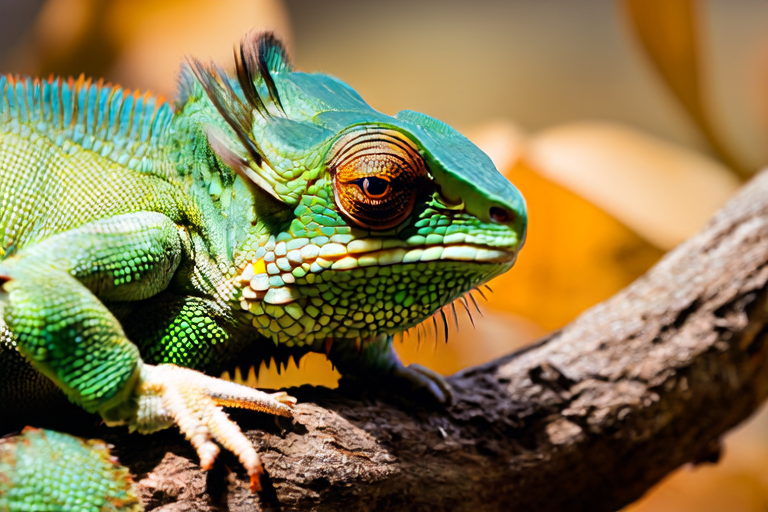Dispelling Common Myths About Chameleons
Chameleons are fascinating creatures that have captured the imagination of many people, both as pets and in nature documentaries. However, there are several myths surrounding these unique reptiles that often lead to misunderstandings about their behavior, health, and care requirements. Let’s dive into five common myths about chameleons and set the record straight with some scientific insights.
Myth 1: Chameleons Change Color to Match Their Environment
The most enduring myth about chameleons is that they change color to blend into their surroundings. While this idea sounds plausible, it’s not entirely accurate. Chameleons actually change color for a variety of reasons, including communication, temperature regulation, and mood changes. Their ability to alter their appearance comes from specialized cells beneath their skin called chromatophores, which contain different pigments. These cells expand or contract based on neural signals, allowing the chameleon to display a range of colors. For example, a chameleon may turn darker to absorb more heat or lighter to reflect sunlight and stay cool. Additionally, males will often change color to signal dominance or readiness to mate, while females might adjust their hues to indicate their reproductive status or warn off potential threats. This process is far more complex than simply mimicking the environment around them.
Myth 2: Chameleons Can Shoot Their Tongues Out Like a Snake
Another misconception is that chameleons shoot their tongues out like snakes. In reality, chameleons have an incredibly powerful and fast tongue that can extend up to twice the length of their body. The mechanism behind this impressive feat involves a highly elastic muscle called the accelerator muscle, which is attached to the hyoid bone. When a chameleon spots its prey, it contracts this muscle rapidly, propelling the tongue forward at speeds of up to 26 body lengths per second. This quick action allows the chameleon to capture insects mid-air with remarkable precision. Unlike snakes, which rely on venom or constriction to subdue their prey, chameleons use their sticky tongues to catch small animals. The tongue tip has a bulbous structure lined with microscopic hooks that help grip onto prey, ensuring a successful catch every time.
Myth 3: Chameleons Prefer Solitary Living
It’s commonly believed that chameleons are solitary creatures and should be kept alone. While chameleons are indeed territorial and can become aggressive when housed together, especially during breeding seasons, this doesn’t mean they cannot coexist peacefully under certain conditions. Some species, such as the veiled chameleon (Chamaeleo calyptratus), can tolerate the presence of others if introduced early and provided with adequate space. However, housing multiple chameleons requires careful planning, including separate feeding areas and hiding spots to minimize stress and competition. Experts recommend keeping only one adult chameleon per enclosure unless you’re experienced and prepared for potential conflicts. Understanding their social dynamics is crucial for creating a healthy and harmonious living environment.
Myth 4: Chameleons Only Need Water From Dew or Rain
One popular myth suggests that chameleons don’t need drinking water because they get enough moisture from dew or rain. This notion stems from observing chameleons in their natural habitats, where they often drink droplets collected on leaves after rainfall. While this method does provide some hydration, it is insufficient for maintaining optimal health in captivity. Chameleons require fresh, clean water daily, just like any other pet. Providing a shallow water dish or misting system ensures they can drink regularly. Dehydration can lead to serious health issues, including kidney problems and reduced immune function. Therefore, it’s essential to offer consistent access to water, especially in indoor environments where humidity levels may be lower than in the wild.
Myth 5: Chameleons Are Easy Pets for Beginners
Perhaps the most dangerous myth is that chameleons make good starter pets for novice reptile owners. While chameleons are undeniably captivating, they come with specific care requirements that can be challenging even for experienced keepers. Proper husbandry includes maintaining appropriate temperatures, humidity levels, lighting, and diet. Many beginners underestimate the complexity of setting up a suitable habitat, leading to health problems for their pets. For instance, incorrect lighting can cause metabolic bone disease, while inadequate humidity may result in respiratory infections. It’s important to research thoroughly before committing to a chameleon as a pet. If you’re new to reptile ownership, consider starting with simpler species that have more forgiving care needs. This approach helps build confidence and knowledge, making it easier to transition to more demanding pets later on.
Summary
In conclusion, chameleons are truly remarkable animals with unique adaptations that serve purposes beyond simple camouflage. They change color for communication, temperature regulation, and mood expression; their tongues are powerful weapons for catching prey; they can sometimes coexist peacefully but require careful management; they need regular access to drinking water; and they demand specialized care that goes beyond basic pet ownership. By understanding these truths, we can better appreciate these amazing creatures and provide them with the best possible care. Remember, debunking myths leads us closer to the truth about these fascinating reptiles, helping us become more responsible and informed pet owners.
